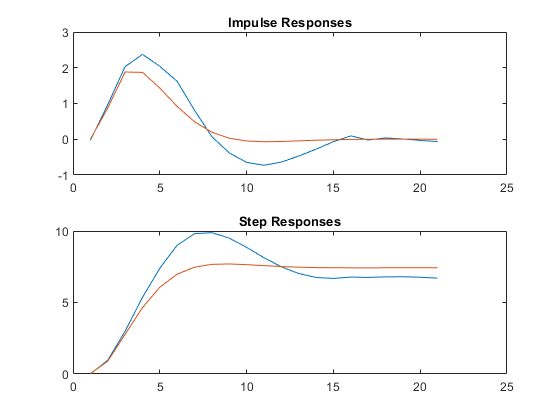cra
Estimate impulse response using input/output data prewhitening before correlation analysis
Syntax
Description
The cra command estimates a single-input, single-output
impulse response from time-domain data by first prewhitening the data and then computing the
covariance and cross-correlation functions. An alternative to cra is
impulseest, which uses a high-order FIR model to estimate the impulse response,
and which may return better results. impulseest also handles MIMO
data.
ir=cra(data)data, which can be
in the form of a timetable, comma-separated pair of numeric
matrices, or iddata object.
cra estimates the impulse response by first estimating an
autoregressive model with which to prewhiten the data and, after prewhitening, computing,
and scaling the cross-correlation function between the input and output data. For more
information about the computation sequence, see Algorithms.
If data is a timetable that contains more than two variables, you
must select a single input channel and single output channel to use for estimation by
specifying the channel names in the InputName and
OutputName name-value arguments. You must also use the
OutputName argument if data contains only two
variables but the output data is in the first variable rather than the second
variable.
sys = cra(___,Name,Value)
For example, specify the input and output signal variable names using sys =
cra(data,'InputName',"u1",'OutputName',"y1").
You can use this syntax with any of the previous input-argument combinations.
Examples
Input Arguments
Name-Value Arguments
Output Arguments
Algorithms
The cra command estimates the impulse response by performing the
following steps:
Compute an autoregressive model for the input u as , where e is uncorrelated (white) noise, q is the time-shift operator, and A(q) is a polynomial of order
na.Filter both u and the output y with A(q) to obtain the prewhitened data.
Compute the covariance functions of the prewhitened u and y data and the cross-correlation function between them.
Plot the functions with 99% confidence levels.
Scale the correlation function to correspond to an impulse of height 1/T and duration T , where
Tis the sample time of the data, so that the scaled function represents an estimate of the system impulse response, and return this function in theiroutput argument.
Positive values of the lag variable correspond to an influence from
u to later values of y. In other words, significant
correlation for negative lags is an indication of feedback from y to
u in the data. The first entry of the impulse response
ir corresponds to lag zero. ir excludes negative
lags.
Version History
Introduced before R2006aSee Also
impulse | step | impulseest | spa
